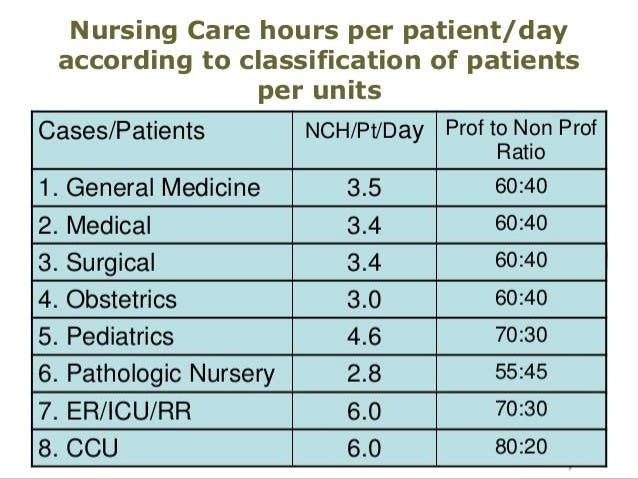Table of Content
Additionally, the report describes several studies that suggest the skill mix of staff (RNs, Licensed Vocational Nurses , CNAs) is as important as staffing levels in ensuring positive care outcomes. This research indicates higher RN and LN ratios lead to better resident outcomes and a proper LN-to-direct care worker ratio is important for supervision as well as for direct care needs. This issue brief highlights major legislative initiatives concerning nurse staffing in nursing homes in the Congress, the Federal Government, and among states from 2000 to 2002.

The proposed minimum total number of direct nursing care staff is 4.13 hprd. The recommendation for total administrative and direct and indirect nursing hours is 4.55 hprd. The report suggests that the recommendations be used as general guidelines for stakeholders in implementing minimum staffing standards. A hospital in Texas is not required to maintain a specific patient-to-nurse ratio in acute care units. Hospitals have adopted ratios in order to provide the best possible care for their patients. According to the most common ratio, the nurse-patient ratio is one nurse per four patients.
#1 Best Caregiver Website in 2022
Table 1 lists state minimum staffing requirements and regulatory state code information. Developing an incentive system that would provide additional Medicaid reimbursement to facilities that increase staffing to meet certain criteria (e.g., minimum staff-to-resident ratios or hours of nursing care per resident day). Another way hospitals are accountable for safe staffing ratios is through the use of nurse-driven staffing committees. In the absence of legal mandates, some states require hospitals to be accountable for staffing ratios through public reporting. Currently, hospitals in Illinois, New Jersey, New York, Rhode Island, and Vermont must provide disclosure about their staffing ratios.

Overall, hospitals seemed to only increase their pay and benefits in order to attract more nurses in the competitive field. Additionally, it doesn’t take long working in a hospital to realize that patient loads can change rapidly and unexpectedly. There is clear evidence to indicate that the number of nurses on a shift plays an important role in patient safety and quality of care. Being active in finding a solution to rising nurse-to-patient ratios could make the difference at your hospital and in your community. If you’re looking to step into a leadership role and make a positive impact, enroll today in King University’s online RN to BSN program.
Are you ready to earn your online nursing degree?
The maximum number of licensed nurses allowed at a nursing home is one per 40 residents. Nurses are playing an increasing role in politics, as more states recognize the importance of nursing-to-patient ratios. You have the option of making a positive difference outside of the hospital as well. By educating elected officials and raising awareness of nursing issues on your own, you can raise nursing issues on your own.
As part of the Texas Safe Hospital Staffing Act, a process and structure for nurses and managers to collaborate on developing staffing plans is established. California was the first state to implement a law requiring nursing minimums in 2004. As a result, the law has resulted in improved patient care as well as a reduction in nurse burnout. A nurse’s patient ratio is the number of patients she or he cares for each shift. The higher the ratio, the more patients a nurse cares for and the less time she spends with each patient.
Ratios for Nurse-Patient Types
The survey collects data on state activities in response to direct care worker shortages. Surveys were sent to the state Medicaid agencies and State Units on Aging for 50 states; data were collected between February and April 2002. Amending Senate Bill 1125 to phase in minimum nursing staff standards in line with the National Citizens' Coalition for Nursing Home Reform's recommendations. The patient ratio in the hospital is the number of patients that are being treated by each nurse. This number can vary depending on the hospital, but the average patient ratio is about four to one. This means that for every four patients in the hospital, there is one nurse responsible for their care.

Nurses work at a higher rate than patients, which is critical for the quality of patient care. The use of these devices can improve patient safety and reduce nurse-patient ratios. As of now, 14 states have enacted legislation requiring patient-to-physician ratios. Following the link, you will be taken to a page where you can look up ratios for each unit. Rhode Island hospitals are required to report hospital staffing to the public once a year. The California RN Staffing Ratio Law defines the number of patients nurses may oversee in each hospital unit.
At the present, California is the only state to have a law mandating specific nurse-to-patient ratios. The law sets these mandated numerical ratios based on the unit’s or facility’s specialty alongside several provisions that make sure the staffing ratios can work effectively. Exactly how many patients per nurse depends on how many staff are available, the patient’s acuity and needs, and the facility’s policies on staffing ratios. In 1999, the registered nurses of the California Nurses Association successfully sponsored and lobbied the California Legislature to pass A.B. 394, the historic bill that made minimum, specific numerical staffing ratios the golden standard in the Golden State.

In general, patients should receive one to two nurses per hour in the emergency room, surgical room, and intensive care unit. As nurses across the country rally for safe nurse-patient ratios on their units, long term care facilities -- also known as nursing homes -- and skilled nursing facilities seem forgotten. When we talk of nurse staffing ratios, we’re usually talking specifically about registered nurse to patient ratios, although facilities will generally factor in licensed practical nurses and unlicensed personnel, like nursing assistants. These measures are intended to illustrate both the quality of nursing care and the degree to which an institution’s working environment supports nurses in their patient safety efforts.
In other words, it represents how many hours a hospital staff must work in order to meet patient needs. In the case of a hospital, the total number of working hours per week is divided by the number of hours worked per day, which allows the number of FTEs required to meet patient needs to be determined. California is the only state in the U.S. to legally require a specific nurse-to-patient ratio in every hospital unit. States without staffing mandates have other ways to hold hospitals accountable for safe patient ratios. When ratios are too high, nurses are often forced to spend their time dealing with agitated or unruly patients rather than taking care of their patients. A recent study found hospitals staffed at 1 nurse per 4 patients, as proposed in legislation, saved an estimated $720 million, as well as 4370 patients’ lives.

When nurses have fewer patients to care for at one time, they’ve shown higher levels of job satisfaction. A study published by labor union AFL-CIO showed that, in contrast to nurses studied in New Jersey and Pennsylvania, California nurses felt their workload was reasonable and led to providing better care. They also reported receiving adequate support services, such as nursing assistants. Quarterly staffing ratios may be used to compare Nursing Homes to one another or to the statewide averages.
A survey of the population conducted by Connecticut nursing population by Connecticut Colleagues in Caring was not available except for previously released summaries. However, this data set was compared to the Connecticut DPH's LN database for the same timeframe and was determined to be representative of the Connecticut nursing population. Federal law and 33 states require that facilities provide sufficient staff to meet the needs of the residents in order to maintain the highest practicable functioning of residents.
For example, hospitals caring for critically ill patients will typically have a higher nurse to patient ratio than those caring for healthy patients. The nurse to patient ratio is the number of patients that a nurse cares for at any given time. In general, one to five nursing positions should be required for surgical units, one to four for intermediate units, and one to two in intensive care units. There would be at least seven nurses on duty on a ward of 28 patients, each working a morning and afternoon shift. When nurses are assigned a specific number of patients, they are better able to provide better care because they will be able to focus on each individual.

No comments:
Post a Comment